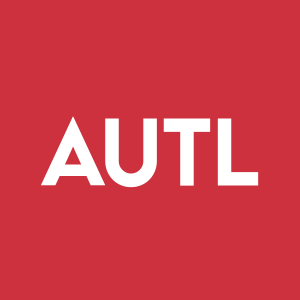Autolus Therapeutics Presents Clinical Data Updates at the American College of Rheumatology Convergence 2025
Rhea-AI Summary
Autolus Therapeutics (NASDAQ: AUTL)50x10^6 cells (±20%) with median follow-up of 8.9 months (range 6.0–13.8).
Key findings: no DLTs, no ICANS, no Grade ≥2 CRS; remission by DORIS in 83.3% (5/6); complete renal response in 50% (3/6); all patients tapered steroids to ≤5 mg/day; deep B-cell depletion followed by naïve B-cell reconstitution. Company expects to dose first Phase 2 LN patient before year-end 2025 and reports alignment with the FDA on trial design.
Positive
- DORIS remission achieved in 83.3% (5/6) of patients
- Complete renal response in 50% (3/6) of patients
- No ICANS or Grade ≥2 CRS reported through median 8.9 months
- 50 million cell target dose selected for Phase 2
- FDA alignment on Phase 2 design and plan to dose first patient by year-end 2025
Negative
- Very small sample size: n=6 limits generalizability
- Median follow-up 8.9 months limits long-term durability evidence
News Market Reaction 3 Alerts
On the day this news was published, AUTL gained 7.84%, reflecting a notable positive market reaction. Argus tracked a peak move of +2.4% during that session. Our momentum scanner triggered 3 alerts that day, indicating moderate trading interest and price volatility. This price movement added approximately $30M to the company's valuation, bringing the market cap to $407M at that time.
Data tracked by StockTitan Argus on the day of publication.
- Data from the Phase 1 CARLYSLE study in severe refractory systemic lupus erythematosus (srSLE) suggests obe-cel is well tolerated with no ICANS or high-grade CRS; 50 million cell dose selected for Phase 2 pivotal study
- Preliminary efficacy data demonstrate achievement of definition of remission in SLE (DORIS) in
83% of patients and complete renal response (CRR) in50% of patients; all responses and remissions are ongoing with no evidence of disease activity at a median follow-up of 8.9 months - All patients had refractory lupus nephritis; 4/6 patients had significantly impaired kidney function
- Patients received no other lupus directed therapy; steroids were tapered in all patients to 5mg by month six
- Company remains on track to dose first patient in Phase 2 trial in lupus nephritis (LN) by year-end 2025
LONDON and GAITHERSBURG, Md., Oct. 27, 2025 (GLOBE NEWSWIRE) -- Autolus Therapeutics plc (Nasdaq: AUTL), an early commercial-stage biopharmaceutical company developing, manufacturing and delivering next-generation programmed T cell therapies, announces that follow-up data from the ongoing CARLYSLE trial, a Phase 1 dose confirmation clinical trial of obe-cel in severe refractory systemic lupus erythematosus (srSLE), will be presented during a poster session at the American College of Rheumatology Convergence 2025.
“Data from the CARLYSLE study shows that obe-cel has the potential to make a meaningful clinical impact in patients with severe refractory SLE who are currently without approved treatment options. We observe durable responses in up to 12 months of follow up and an encouraging safety profile in this difficult to treat patient population. All patients were able to reduce glucocorticosteroids to physiological levels, and responses, including kidney responses, occur early and are durable. The deep depletion of the B-cell lineage seen with obe-cel suggests the possibility of an immune reset and continues to underscore the paradigm shift that CD19 CAR T cell therapy may represent for these patients,” said Dr. Maria Leandro, consultant rheumatologist at UCL Hospitals and senior lecturer at University College London. “We are excited to expand on this data set at another upcoming meeting before year-end.”
Abstract: 2458
Title: Obecabtagene autoleucel (obe-cel), a CD19-targeting autologous chimeric antigen receptor T-cell therapy (CAR T) with a fast off-rate binding domain, in patients with severe, refractory systemic lupus erythematosus (srSLE): preliminary results from the Phase I CARLYSLE study
Session date and time: Tuesday, October 28, 2025; 10:30am - 12:30pm Central Time
Presenting Author: Maria Leandro, MD
Summary: As of August 21, 2025, six patients with srSLE received the obe-cel target dose of 50x106 (±
These follow-up data from the ongoing CARLYSLE clinical trial support progressing obe-cel into a planned Phase 2 study in srSLE patients with active lupus nephritis. The Company has aligned with the U.S. Food and Drug Administration (FDA) on the Phase 2 trial design and potential registrational path to approval and continues to anticipate dosing the first patient in the Phase 2 clinical trial before year-end 2025.
“These data suggest the safety profile observed in srSLE patients is consistent with our considerable experience in acute leukemia and, combined with sustained renal remissions observed, forms a strong foundation for the Phase 2 LUMINA trial. Leveraging our established commercial presence and manufacturing capabilities, we believe we are well positioned to potentially be first to market with a CAR T therapy in srSLE,” said Dr. Christian Itin, Chief Executive Officer of Autolus.
About Autolus Therapeutics plc
Autolus Therapeutics plc (Nasdaq: AUTL) is an early commercial-stage biopharmaceutical company developing, manufacturing and delivering next-generation T cell therapies and candidates for the treatment of cancer and autoimmune disease. Using a broad suite of proprietary and modular T cell programming technologies, Autolus is engineering precisely targeted and controlled T cell therapies that are designed to better recognize target cells, break down their defense mechanisms and eliminate these cells. Autolus has a marketed therapy, AUCATZYL® (obecabtagene autoleucel), and a pipeline of product candidates in development for the treatment of hematological malignancies, solid tumors and autoimmune diseases. For more information, please visit www.autolus.com.
About AUCATZYL® (obe-cel, AUTO1)
AUCATZYL is a B-lymphocyte antigen CD19 (CD19) chimeric antigen receptor (CAR) T cell therapy designed to overcome the limitations in clinical activity and safety compared to current CD19 CAR T cell therapies. AUCATZYL is designed with a fast target binding off-rate to minimize excessive activation of the programmed T cells. AUCATZYL was approved by the FDA for the treatment of adult patients with relapsed or refractory B-cell precursor acute lymphoblastic leukemia on November 8, 2024, and was granted conditional marketing authorization by MHRA in the UK and EMA in the EU in 2025.
INDICATION
AUCATZYL® is a CD19-directed genetically modified autologous T cell immunotherapy indicated for the treatment of adult patients with relapsed or refractory B-cell precursor acute lymphoblastic leukemia (ALL).
IMPORTANT SAFETY INFORMATION
WARNING: CYTOKINE RELEASE SYNDROME, NEUROLOGIC TOXICITIES, and SECONDARY HEMATOLOGICAL MALIGNANCIES
|
WARNINGS AND PRECAUTIONS
Cytokine Release Syndrome (CRS)
Cytokine Release Syndrome (CRS) occurred following treatment with AUCATZYL. CRS was reported in
Cytokine Release Syndrome (CRS) occurred following treatment with AUCATZYL. CRS was reported in
Prior to administering AUCATZYL, ensure that healthcare providers have immediate access to medications and resuscitative equipment to manage CRS. During and following treatment with AUCATZYL, closely monitor patients for signs and symptoms of CRS daily for at least 7 days following each infusion. Continue to monitor patients for CRS for at least 2 weeks following each infusion with AUCATZYL. Counsel patients to seek immediate medical attention should signs or symptoms of CRS occur at any time. At the first sign of CRS, immediately evaluate the patient for hospitalization and institute treatment with supportive care based on severity and consider further management per current practice guidelines.
Neurologic Toxicities
Neurologic toxicities including Immune Effector Cell-associated Neurotoxicity Syndrome (ICANS), which were fatal or life-threatening, occurred following treatment with AUCATZYL. Neurologic toxicities were reported in
The median time to onset of neurologic toxicities was 10 days (range: 1 to 246 days) with a median duration of 13 days (range: 1 to 904 days). Fifty-five percent of patients (35/64) experienced neurologic toxicities after the first infusion but prior to the second infusion of AUCATZYL with a median time to onset of 6 days (range: 1 to 11 days). Among patients with neurologic toxicities, the most common symptoms (>
Immune Effector Cell-associated Neurotoxicity Syndrome (ICANS)
ICANS events occurred in
During and following AUCATZYL administration, closely monitor patients for signs and symptoms of Neurologic Toxicity/ICANS. Following treatment with AUCATZYL, monitor patients daily for at least 7 days. Continue to monitor patients for at least 2 weeks following treatment with AUCATZYL. Avoid driving for at least 2 weeks after each infusion. Counsel patients to seek medical attention should signs or symptoms of neurologic toxicity/ ICANS occur. At the first sign of Neurologic Toxicity/ICANS, immediately evaluate patients for hospitalization and institute treatment with supportive care based on severity and consider further management per current practice guidelines.
Prolonged Cytopenias
Patients may exhibit cytopenias including anemia, neutropenia, and thrombocytopenia for several weeks after treatment with lymphodepleting chemotherapy and AUCATZYL. In patients who were responders to AUCATZYL, Grade ≥ 3 cytopenias that persisted beyond Day 30 following AUCATZYL infusion were observed in
Infections
Severe, including life-threatening and fatal infections occurred in patients after AUCATZYL infusion. Non-COVID-19 infections of all grades occurred in
Grade 3 or higher febrile neutropenia was observed in
Viral reactivation, potentially severe or life-threatening, can occur in patients treated with drugs directed against B cells. There is no experience with manufacturing AUCATZYL for patients with a positive test for human immunodeficiency virus (HIV) or with active hepatitis B virus (HBV) or active hepatitis C virus (HCV). Perform screening for HBV, HCV and HIV in accordance with clinical guidelines before collection of cells for manufacturing.
Hypogammaglobulinemia
Hypogammaglobulinemia and B-cell aplasia can occur in patients after AUCATZYL infusion. Hypogammaglobulinemia was reported in
Immunoglobulin levels should be monitored after treatment with AUCATZYL and managed per institutional guidelines including infection precautions, antibiotic or antiviral prophylaxis, and immunoglobulin replacement.
The safety of immunization with live viral vaccines during or following treatment with AUCATZYL has not been studied. Vaccination with live viral vaccines is not recommended for at least 6 weeks prior to the start of lymphodepleting chemotherapy treatment, during AUCATZYL treatment, and until immune recovery following treatment with AUCATZYL.
Hemophagocytic Lymphohistiocytosis/Macrophage Activation Syndrome (HLH/MAS)
HLH/MAS including fatal and life-threatening reactions occurred after treatment with AUCATZYL. HLH/MAS was reported in
Hypersensitivity Reactions
Serious hypersensitivity reactions, including anaphylaxis, may occur due to dimethyl sulfoxide (DMSO), an excipient used in AUCATZYL. Observe patients for hypersensitivity reactions during and after AUCATZYL infusion.
Secondary Malignancies
Patients treated with AUCATZYL may develop secondary malignancies. T cell malignancies have occurred following treatment of hematologic malignancies with BCMA- and CD19-directed genetically modified autologous T cell immunotherapies. Mature T cell malignancies, including CAR-positive tumors, may present as soon as weeks following infusion, and may include fatal outcomes. Monitor lifelong for secondary malignancies. In the event that a secondary malignancy occurs, contact Autolus at 1-855-288-5227 for reporting and to obtain instructions on the collection of patient samples for testing.
Adverse Reactions
The safety of AUCATZYL was evaluated in the FELIX study in which 100 patients with relapsed or refractory B-cell acute lymphoblastic leukemia (B-ALL) received AUCATZYL at a median dose of 410 × 106 CD19 CAR-positive viable T cells (range: 10 to 480 × 106 CD19 CAR-positive viable T cells with
The most common serious adverse reactions of any Grade (incidence ≥
Please see full Prescribing Information, including BOXED WARNING and Medication Guide.
Forward-Looking Statements
This press release contains forward-looking statements within the meaning of the "safe harbor" provisions of the Private Securities Litigation Reform Act of 1995. Forward-looking statements are statements that are not historical facts, and in some cases can be identified by terms such as "may," "will," "could," "expects," "plans," "anticipates," and "believes." These statements include, but are not limited to, statements regarding the therapeutic potential and expected clinical benefits of obecabtagene autoleucel (obe-cel); the period during which the results of clinical studies or trials will become available; the timing or likelihood of regulatory filings and approvals for product candidates, along with regulatory developments in the US, EU, the UK and other foreign countries. Any forward-looking statements are based on management's current views and assumptions and involve risks and uncertainties that could cause actual results, performance, or events to differ materially from those expressed or implied in such statements. These risks and uncertainties include, but are not limited to, the risks that the impact of worsening macroeconomic conditions on Autolus’ business, financial position, strategy and anticipated milestones, including Autolus’ ability to conduct ongoing and planned clinical trials; Autolus’ ability to obtain a clinical supply of current or future product candidates; the delay of any current or planned clinical trials, whether due to patient enrollment delays or otherwise; Autolus’ ability to successfully demonstrate the safety and efficacy of its product candidates and gain approval of its product candidates on a timely basis, if at all; competition with respect to market opportunities; the risk that Autolus’ preclinical or clinical programs do not advance or result in approved products on a timely or cost effective basis or at all; the results of early clinical trials are not always being predictive of future results; the cost, timing and results of clinical trials; that many product candidates do not become approved drugs on a timely or cost effective basis or at all; and possible safety and efficacy concerns. For a discussion of other risks and uncertainties, and other important factors, any of which could cause Autolus’ actual results to differ from those contained in the forward-looking statements, see the section titled "Risk Factors" in Autolus' Annual Report on Form 10-K filed with the Securities and Exchange Commission, or the SEC, on March 20, 2025 as well as discussions of potential risks, uncertainties, and other important factors in Autolus' subsequent filings with the Securities and Exchange Commission. All information in this press release is as of the date of the release, and Autolus undertakes no obligation to publicly update any forward-looking statement, whether as a result of new information, future events, or otherwise, except as required by law. You should, therefore, not rely on these forward-looking statements as representing Autolus’ views as of any date subsequent to the date of this press release.
Contact:
Amanda Cray
+1 617-967-0207
a.cray@autolus.com








